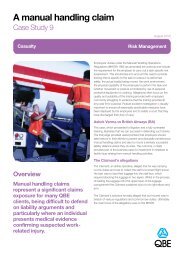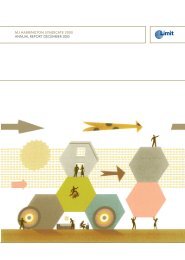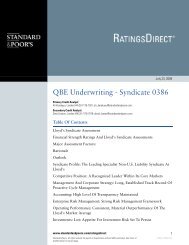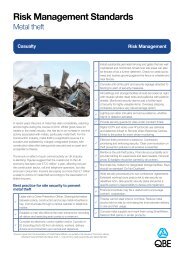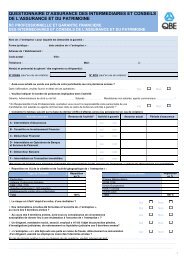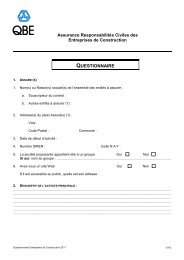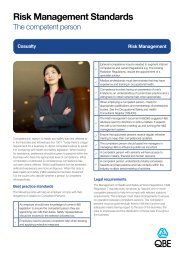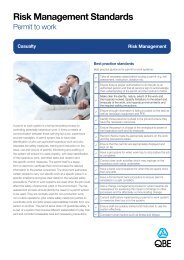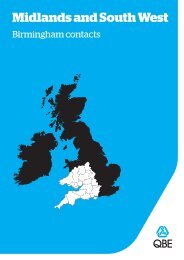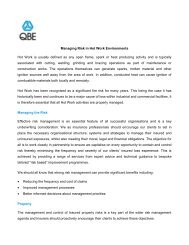QBE European Operations plc
QBE European Operations plc
QBE European Operations plc
You also want an ePaper? Increase the reach of your titles
YUMPU automatically turns print PDFs into web optimized ePapers that Google loves.
<strong>QBE</strong> <strong>European</strong> <strong>Operations</strong> <strong>plc</strong> Annual report 2011<br />
50<br />
Notes to the financial statements<br />
For the year ended 31 December 2011<br />
1 Accounting policies<br />
The principal accounting policies adopted in the preparation of these<br />
financial statements are set out below. These policies have been<br />
consistently applied to all the years presented unless otherwise stated.<br />
The consolidated financial statements incorporate the assets, liabilities<br />
and results of the company and its subsidiary undertakings and are<br />
drawn up to 31 December each year.<br />
a) Basis of preparation<br />
These financial statements have been prepared in accordance with<br />
the provisions of The Large and Medium-Sized Companies and Groups<br />
(Accounts and Reports) Regulations 2008 (SI 2008/410) relating to<br />
insurance groups and applicable accounting standards in the United<br />
Kingdom. The Group has adopted the recommendations of the<br />
Statement of Recommended Practice on Accounting for Insurance<br />
Business issued by the Association of British Insurers in December<br />
2005 (as amended in December 2006).<br />
Compliance with Statement of Standard Accounting Practice (SSAP) 19,<br />
“Accounting for Investment Properties” requires departure from the<br />
requirements of the Companies Act 2006 relating to depreciation and<br />
explanation of the departure is given in Accounting Policy 1(g) below.<br />
b) Basis of consolidation<br />
The results of subsidiary undertakings acquired or sold during the period<br />
are included in the consolidated results from the date of acquisition or up<br />
to the date of disposal. On acquisition of a subsidiary undertaking, the<br />
Group’s share of its assets and liabilities that exist at the date of acquisition<br />
are recorded at their fair values reflecting their condition at that date.<br />
c) Cash flow statement and related party disclosures<br />
The Group and company is included in the consolidated financial<br />
statements of <strong>QBE</strong> Insurance Group Limited, which are publicly available.<br />
Consequently, the Group and company have taken advantage of the<br />
exemption from preparing cash flow statements allowed under Financial<br />
Reporting Standard (FRS) 1 (revised 1996). The Group and company are<br />
also exempt under FRS 8 from disclosing related party transactions with<br />
other entities that are wholly owned by <strong>QBE</strong> Insurance Group Limited.<br />
d) Basis of accounting for insurance<br />
The result is determined on an annual basis whereby the incurred cost<br />
of claims, commissions and related expenses are charged against the<br />
earned proportion of premiums, net of reinsurance, as described below.<br />
i) Premiums written<br />
Premiums written comprise premiums on contracts incepted during the<br />
financial year, together with adjustments made in the year to premiums<br />
written in prior years. Premiums are shown gross of commissions payable<br />
to intermediaries and exclude taxes and duties levied on them. Estimates<br />
are included for premiums due but not yet received or notified, less an<br />
allowance for cancellations.<br />
ii) Unearned premiums<br />
Unearned premiums represent the proportion of premiums written in the<br />
year that relate to the unexpired terms of policies in force at the balance<br />
sheet date, calculated on the basis of established earnings patterns.<br />
iii) Acquisition costs<br />
A portion of acquisition costs, which represent commission and other<br />
related expenses, is deferred in recognition that it represents a future<br />
benefit. Deferred acquisition costs are measured at the lower of cost and<br />
recoverable amount and amortised over the period in which the related<br />
premiums are earned.<br />
iv) Claims incurred<br />
Claims incurred comprise claims and related expenses paid in the year<br />
and changes in provisions for outstanding claims, including provisions<br />
for claims incurred but not reported and related expenses, together with<br />
any other adjustments to claims from previous years. Where applicable,<br />
deductions are made for salvage and other recoveries.<br />
v) Claims provisions and related reinsurance recoveries<br />
Provision is made at the year end for the estimated cost of claims<br />
incurred but not settled at the balance sheet date, including the cost<br />
of claims incurred but not yet reported to the Group. The estimated<br />
cost of claims includes expenses to be incurred in settling claims and<br />
a deduction for the expected value of salvage and other recoveries.<br />
Outstanding claims and reinsurance recoveries are estimated by<br />
reviewing individual claims cases and making allowance for claims<br />
incurred but not reported, using past experience and trends adjusted<br />
for foreseeable events.<br />
Case estimates are set by experienced claims technicians, applying their<br />
skill and specialist knowledge to the circumstances of individual claims.<br />
The ultimate cost of outstanding claims, including claims incurred but not<br />
reported, is estimated by the Group’s actuaries who apply recognised<br />
actuarial techniques considered appropriate for each portfolio, such<br />
as chain ladder and Bornhuetter-Ferguson methods. These methods<br />
take into account, amongst other things, statistical analysis of the<br />
development of the value and frequency of past claims and the results of<br />
analyses undertaken at the point of underwriting. Techniques considered<br />
appropriate for specific portfolios include contract by contract analysis,<br />
segmentation by subclass and stochastic analysis. Classes of business<br />
are analysed at a level of detail appropriate to their materiality. Allowance<br />
is made for changes or uncertainties which may create distortions in the<br />
underlying statistics or which might cause the cost of unsettled claims to<br />
increase or decrease when compared with the cost of previously settled<br />
claims, for example, one-off occurrences and changes in mix of business,<br />
policy conditions or the legal environment. The best estimate of reserves<br />
for the Group is produced and reviewed by a combination of internal and<br />
external actuarial review and is then assessed by <strong>QBE</strong> management with<br />
input from underwriting and claims experts.<br />
As provisions for claims outstanding are based on information which<br />
is currently available, the eventual outcome may vary from the original<br />
assessment depending on the nature of information received or<br />
developments in future periods. For certain classes of business including<br />
liability and other long-tail classes written by the Group, claims may not<br />
be apparent for many years after the event giving rise to the claim has<br />
happened. These classes will typically display greater variation between<br />
initial estimates and final outcomes. Differences between the estimated<br />
cost and subsequent re-estimation or settlement of claims are reflected<br />
in the technical account for the year in which these claims are<br />
re-estimated or settled.<br />
Provisions are calculated gross of any reinsurance recoveries. A separate<br />
estimate is made of the amounts that will be recoverable from reinsurers<br />
based upon the gross provisions and having due regard to collectability.<br />
vi) Unexpired risks provision<br />
Provisions are made for any deficiencies arising when unearned<br />
premiums, net of associated acquisition costs, are insufficient to meet<br />
expected claims and expenses after taking into account future investment<br />
return on the investments supporting the unearned premiums provision



